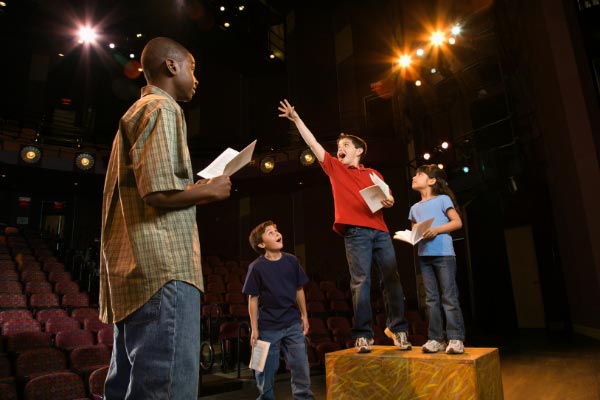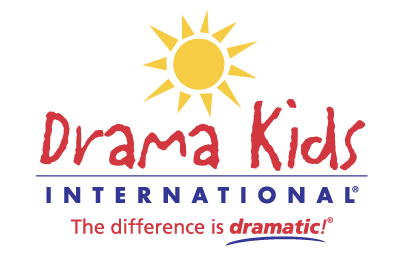[av_textblock size=” av-medium-font-size=” av-small-font-size=” av-mini-font-size=” font_color=” color=” id=” custom_class=” av_uid=’av-kmzbyqic’ admin_preview_bg=”]

There are so many terms that are used in the theatre and it is useful to know them no matter the experience level! Even as a casual viewer, having this theatrical knowledge can help enhance any future theatre visit.
The Theater
Here we will explore the physical space of the theatre from the perspective of the audience.
- Orchestra: The section of seats closest to the stage, on the main floor of the theater. These are often the most prized and expensive seats in the theater.
- Mezzanine: The second seating tier, usually overhanging the orchestra at its midpoint. Not quite as large as the orchestra, front mezz seats are preferred seating for many theatre-goers as they allow you to be close to the action while taking in a more complete stage picture.
- Balcony: The third tier of seating, located farthest from the stage. The “cheap seats,” usually the most inexpensive in the house.
- Orchestra Pit: A lowered area located directly between the stage and the orchestra section where the musicians perform.
- Boxes: Tiered-seating located close to and on either side of the stage.
The Stage
From how a stage is set up, to stage directions, there are many terms here to help a budding actor navigate the stage space.
- The Fourth Wall: An invisible dividing “wall” between the stage and audience. Actors will sometimes “break the fourth wall” and interact with or speak directly to the audience.
- Proscenium: The most traditional stage set-up. The stage is removed from the audience and framed by an arch that separates it from the audience.
- Thrust: A stage that protrudes directly into the audience, shattering the fourth wall, and allowing seating on three sides of the stage.
- In the Round: A circular playing space in which the audience completely surrounds the playing space and the performers.
- Directions: Standing on the stage facing the audience, your right is stage right, your left is stage left. Center stage is exactly that and it’s the most prominent spot onstage. Downstage center is as close as you can get to the audience from the center-most position of the stage. From the audience, your right is stage left and your left is stage right!
The Text
Theatre begins with the words the writer has put on the page. Remember: actors are storytellers and the playwright’s words create the map that guides the actor through the story.
- The Play: A story written specifically for the stage, usually containing one or more characters, dialogue, and a story arc.
- The Musical: Similar to a play, only it employs music to aid in the storytelling.
- Book: The script of the musical that includes characters, dialogue, etc.
- Music: The composer-written music in a musical.
- Lyrics: The words to the song.
The Creative Team
Theatre is a team effort. There are so many people who work together to put on a single show from the creative team, to the actors, to the box office staff, and so much more!
- Collaboration: No theatre could be achieved without everyone working together. The team of a musical is a great example of collaboration because it takes many people working closely together to achieve a common vision.
- Director: The captain of the ship, ultimately responsible for all creative and artistic decisions in the production.
- The Producer: Plans and coordinates all aspects of a production, usually puts up and helps raise money to make the show possible.
- Choreographer: Responsible for telling the story through dance.
- Music Director: Oversees all musical aspects of the production.
- Designers: Responsible for all the physical and auditory aspects of the production. Includes costume, lighting, set, props, etc.
- Conductor: Sometimes also the Music Director, the conductor sets the musical tempos of each number, shapes phrasing, and leads the orchestra and the performers during the show.
The Cast
The cast must work together to create a new world on the stage. It is made up of actors who rehearse together and perform together and no one actor is more important than another.
- Leading Actor: The main character, the protagonist.
- Supporting/Character Actor: A secondary character whose role is to support or conflict with the lead.
- Ensemble: Sometimes called “the chorus,” members of the ensemble are called upon to sing, dance, and play smaller roles in a musical.
- Understudy: Usually a member of the ensemble, this actor will be responsible for learning the part of a leading or supporting actor.
- Swing: Usually off-stage, the swing is a multi-talented performer who’s responsible for learning many ensemble tracks so that they can “swing on” when someone is ill, injured, or missing the performance for any reason.
- Stand-By: An off-stage cover for the lead or star of a show, a standby is usually not in the show in any way and often doesn’t need to be at the theatre during the performance.
The Crew
The crew work alongside the cast to run all the backstage jobs that make a show magical!
- Production Stage Manager (PSM): The hardest job in show business, responsible for coordinating every aspect of the production from scheduling to calling all of the cues during a performance to maintaining the director’s artistic vision of the show once performances have begun.
- Assistant Stage Manager (ASM): Assists the PSM in all of the above aspects.
- Production Assistant (PA): Usually involved in a production from pre-production through the opening. A PA helps get the space ready, runs errands, sets props, and does anything necessary to support the Stage Management team.
- Running Crew: These are all of the people backstage during a show who help set scenery, props, and costumes during a performance.
Rehearsal
Rehearsal is the time for everyone to learn the show from top to bottom and get a sense of how it works, what is needed to tell the story, learn the music and the blocking, etc.
- Call Time: The time you have to show up for rehearsal or performance, as dictated by your Stage Manager. This will either be sent to you via call, text, or email. It is very important that the cast and crew are present and on time!
- Blocking: The path the actors take onstage as decided upon by the actor and director, and notated by the SM. Once blocking has been solidified, it’s not to be changed for any reason without approval from the director.
Tech
The most amazing and stressful part of the process. These are the days when all of the collaborators are in the theater working to put the pieces together.
- 10 out of 12: Some days in tech will be designated a 12-hour workday, 10 of those hours spent working with two hours allowed for meals and breaks.
- Sitzprobe: A German word that describes the first time the performers sit and run through the full score with the orchestra.
- Invited Dress: The last night of tech when members of the production are allowed to invite one or two guests to view the show. It’s the opportunity for everyone to do a run in front of a “friendly” house before paying customers arrive.
The Run
It is time to perform the show in front of an audience! “The run” of a show refers to a show that is currently being performed. As soon as the curtain falls on the final performance, “the run” of the show is over.
- Opening Night: The show can no longer be changed by the actors! This is the evening when family and friends come to see the show and celebrate your achievement. A big party usually happens after the performance.
- Half Hour: Every actor needs to be in the theater at least a half-hour before the performance time, if not earlier.
- Fight Call: If there is any kind of physical altercation in the production, a specific amount of time will be set before half-hour to run this, overseen by SM, to make sure everyone is comfortable and safe.
- 5 Minute Call: The Stage Manager will announce that there are 5 minutes until all actors should be in places. This is usually met with actors responding “Thank you, five!”
- Places: Stage Manager will announce places when it is almost time for the show to begin and all actors should leave the dressing rooms to get ready for their entrances. This is usually met with actors responding “Thank you!” so the SM knows they heard and are on the way.
Superstitions + Sayings
The art of theatre, being as old as it is, has picked up some to do’s and not to do’s! Every theatre company and performance space has their own traditions or superstitions they believe in but here are a few that seem to be universal.
- Ghost Light: Before the entire theater is closed for the evening, all lights except for a single, exposed, incandescent bulb are left on stage. For practical purposes, to allow the first person in the next day some light to find the main switches. For superstition, to give the ghosts who inhabit the theater some light to perform by.
- Macbeth: Never say the title of this Shakespeare play in the theater unless you’re performing it. It is believed to be cursed. If you do say it, you must leave the theater, spin around three times to your left, spit, curse, and then knock to be admitted back in.
- Break a leg: It is bad luck to wish “good luck” to an actor before a performance! Instead say, “Break a leg.” This is because it is believed that wishing someone good luck makes them a target for bad luck to come their way. When wishing “break a leg” it is referring to a time in entertainment when breaking a leg meant “breaking” or parting a “leg” or curtain to perform on stage. Parting a curtain led to booking an acting gig and getting paid, which is a great thing to wish for an actor!
Flex this new knowledge of theatre terms and learn several more in one of our many after-school drama programs. Find your nearest Drama Kids and discover what classes are going on in your area!
